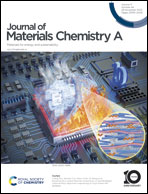High-performance ultrathin perfluorinated sulfonic acid membranes with thermo-morphology control for a vanadium redox flow battery†
Abstract
A proton exchange membrane (PEM) is a crucial component for the effective and stable operation of energy conversion and storage devices, such as fuel cells, water electrolyzers, and redox flow batteries. However, perfluorinated sulfonic acid (PFSA) membranes—the most widely used PEM—have ultimate limitations of low proton selectivity to other active species because of their wide and randomly connected proton channels. Many attempts have been made to enhance the ion selectivity through morphology control, but it is still necessary to achieve significant improvement to overcome the permeability–selectivity trade-off. In this study, we demonstrate an ultrathin (∼30 nm) PFSA membrane with highly ordered hydrophilic domains. The well-controlled nanostructures are generated from the pre-aligned PFSA ionomers on the aqueous substrate, and further morphology development in the size and orientation of domains, and crystallinity, is finely adjusted via thermal annealing. Through this bottom-up morphology control, the ultrathin membrane has highly aligned ion channels with 55% crystallinity, resulting in about 800 times higher proton selectivity and 2 orders of magnitude lower areal resistance compared to 25 μm-thick PFSA membranes (Nafion 211). Furthermore, when the ultrathin membrane is applied to a vanadium redox flow battery (VRFB), the cell shows higher energy efficiency (∼76%) than a cell with a commercial Nafion membrane at the current density of 200 mA cm−2.



 Please wait while we load your content...
Please wait while we load your content...